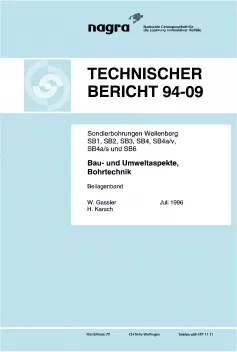
Technischer Bericht NTB 94-09
Sondierbohrungen Wellenberg SB1, SB2, SB3, SB4, SB4a/v, SB4a/s und SB6 – Bau- und Umweltaspekte, Bohrtechnik
As part of its overall responsibility for finding a safe means of disposal for all categories of radioactive waste, Nagra has investigated a range of potential host rocks for a repository for low- and intermediate-level waste. Comprehensive investigation programmes were carried out at four sites – Piz Pian Grand (GR), Oberbauenstock (NW), Bois de la Glaive (VD) and Wellenberg (NW). The Valanginian Marls at Wellenberg have a number of properties which make them suitable as a host formation, namely their sorption properties, their plastic behaviour under mechanical loading and, in particular, their low water permeability.
On 17th June 1987, Nagra submitted an application (NSG 18) for permission to carry out an extensive exploration programme at Wellenberg, with a view to assessing the suitability of the site for construction of a repository for low- and intermediate-level waste. The decision of the Federal Council of 31st August 1988 granted permission to carry out investigations which would not disturb the potential disposal zone. As well as investigations from the surface, i.e. seismic surveys and deep boreholes, this included construction of an exploratory drift. For licensing reasons, construction of the drift had to be put on hold but the surface-based investigations went ahead.
Initial activities in Phase I of the programme included continuation of mapping studies and hydrogeological surveying. Geophysical investigations (reflection and refraction seismics and geoelectrics) were then carried out between 18th September and 27th November 1989. In the Engelberg Valley, between Dörfli and Mattli, six piezometer boreholes were drilled and equipped between 21st November 1989 and 12th January 1990.
The first five exploratory boreholes formed the focal point of the Phase I investigations. The programme began, on 20th November 1989, with construction of the drillsites at Schwandrain (SB4) and Wilershöchi (SB3). Actual drilling started on 15th May 1990 at SB4 and was completed on 5th March 1993 with the Allmend borehole (SB2). The latter site is located in the future repository portal zone and was partly recultivated. Apart from ongoing long-term monitoring programmes, the installation of a packer system in SB6 in summer 1993 completed the work in this first investigation phase.
Building on the results from Phase I, a second stage in the Wellenberg site characterisation programme was initiated in summer 1994. Phase II included a further surface seismic campaign, several piezometer boreholes and shallow cored boreholes. Borehole SB4a consisted of both a vertical and an inclined (45 degrees) hole and sealing of the inclined hole brought this stage of investigations to an end in November 1995.
The first chapter of this report discusses regional geology, the aims of the investigation programme and the timetable which was followed. Licensing and environmental issues are discussed in chapter 2, which deals both with general aspects of construction and operation and with the specific measures taken for noise protection. Chapter 3 describes the drilling techniques used and chapters 4 to 10 each discuss one borehole in detail. Chapter 11 addresses supervisory bodies and documentation of the programme.
The total number of metres drilled from the six sites was around 7869, of which 96 % were drilled using the wire line coring technique. Core recovery was 97 %. The aim of the wide range of investigations carried out in the boreholes was to characterise the geology of the Wellenberg site, with a view to assessing its suitability as a host formation for construction of a repository.
The results from the first drilling campaign fulfilled, and in some cases even surpassed, all expectations. They formed the basis for the siting decision in favour of Wellenberg and for initiation of the general licensing procedure. Positive use was made of the time delays encountered in the licensing procedure for underground exploration by aiming the second drilling campaign at confirming existing results and providing additional information.
